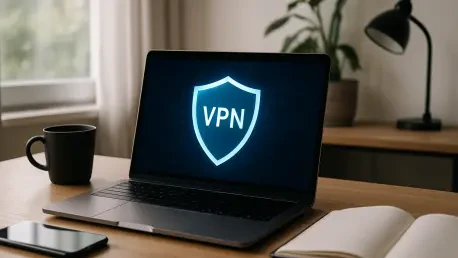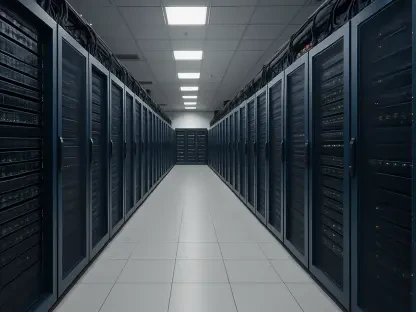Imagine a sprawling enterprise network, with employees accessing sensitive data from remote locations across the globe, all secured by a single gateway technology. Now picture that gateway under relentless siege by hundreds of malicious actors aiming to breach its defenses. This scenario is not hypothetical but a stark reality for many organizations using Fortinet SSL VPN solutions, as recent brute-force attacks have exposed potential vulnerabilities. This review delves into the security landscape of Fortinet’s SSL VPN technology, examining its role in enterprise cybersecurity and evaluating its resilience against evolving threats.
Overview of Fortinet SSL VPN Technology
Fortinet SSL VPN stands as a cornerstone for secure remote access, enabling organizations to connect employees, partners, and clients to internal networks over encrypted channels. Designed to safeguard sensitive information, this technology leverages Secure Sockets Layer protocols to ensure data integrity and confidentiality during transmission. Its appeal lies in the balance of robust security features with user-friendly deployment, making it a popular choice for businesses navigating the complexities of remote work environments.
Beyond basic encryption, Fortinet SSL VPN integrates with FortiOS, offering advanced functionalities such as multi-factor authentication and endpoint security checks. These features aim to prevent unauthorized access while ensuring that connected devices meet compliance standards. For enterprises, this means a scalable solution that can adapt to growing user bases without compromising on protection.
The significance of this technology extends to its role in critical infrastructure, where downtime or breaches can have catastrophic consequences. As remote access becomes indispensable, understanding how Fortinet SSL VPN performs under pressure is paramount for IT decision-makers. This review focuses on recent challenges that test the system’s durability against sophisticated cyber threats.
Performance Under Fire: Brute-Force Attack Analysis
First Wave of Attacks on FortiOS
On August 3, a coordinated wave of brute-force attacks targeted Fortinet SSL VPNs, involving over 780 unique malicious IP addresses. These attacks displayed a consistent TCP signature, indicating a deliberate and structured approach using a FortiOS profile. Such precision suggests that threat actors were not merely casting a wide net but specifically aiming to exploit weaknesses in this widely used platform.
Geographically, the malicious IPs originated from diverse locations, including the United States, Canada, Russia, and the Netherlands. Meanwhile, targeted systems spanned regions like the United States, Hong Kong, Brazil, Spain, and Japan. This global distribution underscores the widespread nature of the threat, affecting organizations across multiple continents and industries.
The intensity of this initial campaign highlights a critical performance concern for Fortinet SSL VPNs: the ability to withstand sustained, focused assaults. While the technology’s encryption and authentication mechanisms are robust on paper, real-world stress tests like these reveal the importance of continuous monitoring and rapid response capabilities to thwart such persistent efforts.
Strategic Shift to FortiManager Systems
Following the initial onslaught, a second wave of attacks emerged after August 5, characterized by a sudden burst of traffic with a distinct TCP signature. This shift marked a strategic pivot, as threat actors redirected their focus from FortiOS to FortiManager, another integral component of Fortinet’s ecosystem. This change suggests either an adaptation in tactics or the deployment of new tools by the attackers.
The move to target FortiManager indicates a deeper probing of Fortinet’s portfolio, searching for alternate entry points into enterprise networks. Such adaptability among threat actors poses a significant challenge to the technology’s defensive architecture, as it must secure multiple interconnected systems against evolving attack patterns.
This development raises questions about the overall resilience of Fortinet’s solutions when faced with dynamic threats. The ability of attackers to switch targets within the same vendor’s suite emphasizes the need for comprehensive security measures that protect all components equally, rather than focusing solely on the primary VPN gateway.
Evolving Threat Landscape and Historical Insights
The recent attacks on Fortinet systems are not isolated incidents but part of a broader pattern of evolving cyber threats. Threat actors have demonstrated remarkable flexibility, adjusting their strategies over time to exploit different vulnerabilities. This adaptability is evident in the transition from one attack signature to another, reflecting a calculated effort to stay ahead of defensive measures.
Historical data provides further context, revealing an earlier spike in malicious activity during June tied to a unique client signature. This incident was linked to a FortiGate device on a residential ISP block, raising suspicions about the use of home networks or proxies to mask attack origins. Such tactics complicate attribution and highlight the sophistication of modern cybercriminals in concealing their tracks.
These patterns suggest that Fortinet SSL VPN and related technologies must contend with increasingly cunning adversaries. The use of residential infrastructure for launching attacks adds a layer of difficulty in distinguishing legitimate traffic from malicious attempts, underscoring a critical area for improvement in threat detection and mitigation strategies.
Implications for Enterprise Security
The brute-force campaigns targeting Fortinet SSL VPNs carry profound implications for organizations that rely on this technology for secure operations. Breaches in such systems can expose sensitive data, disrupt business continuity, and even compromise critical infrastructure. The global reach of these attacks means that no sector or region is immune, amplifying the stakes for enterprises worldwide.
Another concerning trend is the potential connection between these malicious spikes and the subsequent disclosure of new vulnerabilities within a short timeframe. Historical trends indicate that such activity often precedes the identification of exploitable flaws, putting organizations at risk of zero-day attacks if defenses are not proactively strengthened.
For IT teams, these incidents serve as a stark reminder of the importance of robust security postures. Relying solely on the inherent protections of Fortinet SSL VPNs may not suffice in the face of determined adversaries, necessitating additional layers of defense such as intrusion detection systems and regular security audits to safeguard critical assets.
Challenges in Securing Fortinet Solutions
Defending against coordinated brute-force attacks presents significant technical hurdles for Fortinet users. The use of residential proxies or networks to obscure attack origins makes tracing and blocking malicious activity a daunting task. Traditional IP-based filtering often falls short when attackers blend into legitimate traffic patterns, requiring more advanced behavioral analysis tools.
Beyond specific attacks, the broader challenge lies in protecting enterprise edge technologies like VPNs, which are inherently exposed to external threats. As the primary gateway for remote access, these systems are prime targets for exploitation, demanding constant vigilance and updates to address emerging vulnerabilities.
Fortinet’s ongoing efforts to enhance system security are crucial, but users must also adopt proactive measures. Implementing strict access controls, enforcing strong password policies, and deploying real-time monitoring can mitigate risks, though these require consistent investment and expertise to maintain effectively over time.
Looking Ahead: Future Security Prospects
As cyber threats continue to evolve, the trajectory for Fortinet SSL VPN security points toward an increase in targeted exploits and potential new vulnerabilities. Threat actors are likely to refine their approaches, seeking out undiscovered weaknesses in both FortiOS and FortiManager systems. Staying ahead of these risks will require vigilant patching and rapid response mechanisms from both the vendor and end-users.
Fortinet’s commitment to bolstering its platforms through regular updates and security enhancements will be pivotal in maintaining trust among enterprises. Collaboration with threat intelligence communities to anticipate and counter emerging attack vectors could further strengthen the technology’s defensive capabilities in the coming years, from 2025 onward.
The long-term impact on enterprise confidence in SSL VPN solutions hinges on the ability to adapt to an ever-changing threat landscape. Organizations must prioritize evolving cybersecurity strategies, integrating Fortinet’s tools with broader protective frameworks to ensure resilience against sophisticated and persistent adversaries.
Final Thoughts and Recommendations
Reflecting on this evaluation, the brute-force attacks on Fortinet SSL VPN and FortiManager systems exposed critical insights into the technology’s performance under duress. The coordinated nature of the assaults, coupled with attackers’ strategic shifts, tested the limits of existing security measures and revealed areas needing urgent attention. These incidents underscored the reality that no solution is impervious to determined threats.
Moving forward, organizations that depend on Fortinet solutions are advised to implement multi-layered defenses, including enhanced authentication protocols and continuous network monitoring. Exploring partnerships with cybersecurity experts to conduct regular vulnerability assessments proves essential in identifying potential weak points before exploitation occurs. Additionally, staying informed about threat intelligence updates offers a proactive way to anticipate future risks.
Ultimately, the path ahead demands a collaborative effort between Fortinet and its user base to fortify systems against adaptive adversaries. Investing in advanced threat detection tools and fostering a culture of security awareness within enterprises emerges as actionable steps that can significantly elevate protection levels, ensuring that remote access technologies remain a reliable safeguard in an increasingly hostile digital environment.









